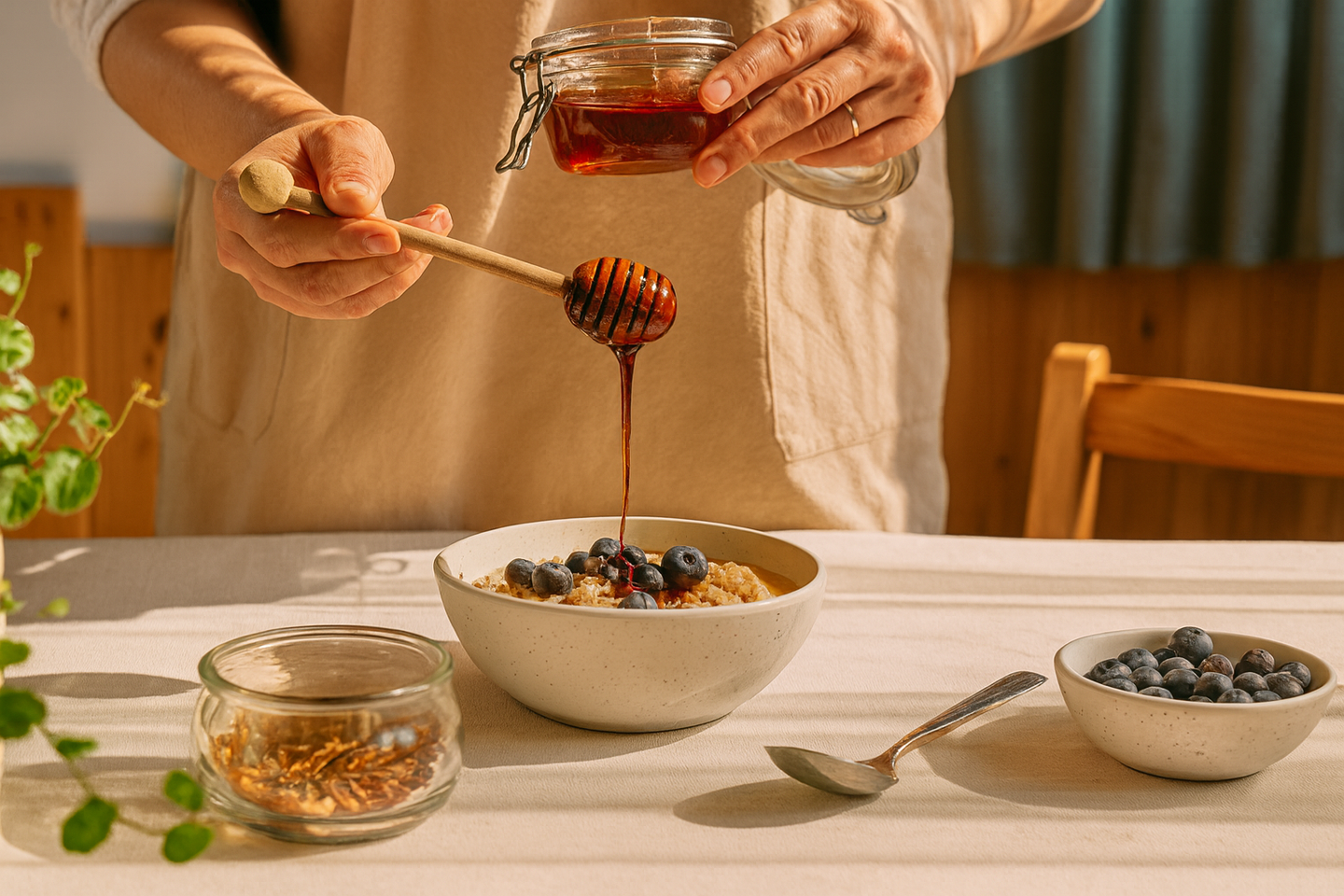Rich chocolate-flavored honey delivers heart health and antioxidant benefits
Brazilian scientists turned cocoa shells and native bee honey into chocolate flavored honey rich in antioxidants and heart friendly compounds.

 Edited By: Joseph Shavit
Edited By: Joseph Shavit

This honey usually has more water and lower thickness than honey from European bees. (CREDIT: Shutterstock)
In a university lab in Brazil, a pot of honey and a pile of discarded cocoa shells have become the starting point for a new kind of chocolate experience. Instead of being burned or thrown away, those shells are now the raw material for a rich, chocolate flavored honey that also carries compounds linked to heart health and antioxidant benefits.
Turning Cocoa Waste Into a New Kind Of Honey
The product was created by researchers at the State University of Campinas in São Paulo. Their work, featured on the cover of ACS Sustainable Chemistry & Engineering, started with a simple question. Could they use an edible, natural solvent to pull useful compounds out of cocoa bean shells.
The shells are left over after cocoa beans are roasted and cracked to make chocolate. They still contain stimulants like theobromine and caffeine, along with phenolic compounds that have antioxidant and anti inflammatory activity. The team chose honey from native stingless bees as their solvent. This honey usually has more water and lower thickness than honey from European bees, which helps it soak into plant material and dissolve bioactive compounds.
Using an ultrasound probe in a beaker of honey and crushed shells, the scientists triggered tiny bubbles that formed and collapsed in rapid bursts. Those bubbles briefly raised local temperature and pressure, breaking open plant structures and helping theobromine, caffeine and phenolics move into the honey.
A Chocolate Taste With Extra Bioactive Punch
The result is a thick, aromatic honey that can be eaten on its own or used in foods and cosmetics. Researchers who tasted early batches said that, depending on the ratio of shells to honey, the flavor can be strongly reminiscent of chocolate.
“Of course, the biggest appeal to the public is the flavor, but our analyses have shown that it has a number of bioactive compounds that make it quite interesting from a nutritional and cosmetic point of view,” said Felipe Sanchez Bragagnolo, first author of the study and postdoctoral researcher at the Faculty of Applied Sciences at UNICAMP.
Laboratory tests confirmed that the enriched honey carries measurable levels of theobromine and caffeine, both linked to cardiovascular effects. It also contains phenolic compounds that help neutralize harmful free radicals and support anti inflammatory pathways. For you, that means this is not just a novelty spread. It is a sweetener that may offer added functional benefits.
Native Bees at the Center of the Process
The group did not rely on a single type of honey. They worked with five species of stingless bees found in Brazil: borá, jataí, mandaçaia, mandaguari and moça branca. Shells came from a cocoa processing unit supported by the São Paulo state agriculture department.
For process optimization, the team began with honey from mandaguari bees. That honey had intermediate water content and viscosity, which made it a good starting point. Once the researchers fine tuned the ultrasound settings and shell to honey ratio, they applied the same conditions to the other honeys.
Bragagnolo notes that honey composition changes with climate, storage and handling. Because of that, the method can be adapted to whatever native bee honey is available locally. Producers would not be locked into one species or one region. If you keep bees or work with small cocoa producers, that flexibility matters.
Green Chemistry and a Positive Sustainability Score
The scientists wanted more than a tasty product. They set out to design a process that meets green chemistry goals. Ultrasound assisted extraction is considered an environmentally friendly technique in the food sector. It works quickly, uses less energy than many traditional methods and relies on safe solvents.
To quantify sustainability, the team used Path2Green software developed at UNICAMP. The tool checks how well a process aligns with 12 principles of green chemistry, including waste reduction, energy use and safer materials. On a scale from minus one to plus one, the honey process scored plus 0.118.
Using an edible, local solvent that needs no extra purification helped raise that score. So did the use of a plant residue that would otherwise be discarded. Professor Mauricio Ariel Rostagno, who supervised the work, believes the process is especially suited to small businesses.
“We believe that with a device like this, in a cooperative or small business that already works with both cocoa and native bee honey, it’d be possible to increase the portfolio with a value added product, including for haute cuisine,” he said.
Longer Shelf Life and New Uses on the Horizon
Honey from stingless bees usually needs more care than honey from European bees. It tends to have higher moisture and more active microbes, so it is often refrigerated, dehumidified or pasteurized. The team suspects the ultrasound process may help here as well.
As sound waves and microbubbles break plant cell walls, they may also disrupt bacterial cells and other microorganisms that spoil honey. The next round of studies will test whether ultrasound alone can lower microbial loads and extend shelf life. If that works, you could see native bee honey products that are more stable at room temperature.
The researchers are also planning to use native bee honey as a solvent for other plant residues. Cocoa shells may be only the first step. Many crops leave behind peels, husks or leaves with valuable compounds still inside. Honey based extraction could turn those leftovers into ingredients for foods, drinks or skincare lines.
Through INOVA UNICAMP, the university’s innovation agency, the group has filed a patent and is looking for partners to license the technology. A company already working with cocoa or native bee honey would be well placed to bring this chocolate flavored honey to market.
Practical Implications of the Research
This work shows how you can turn a low value by product into a premium ingredient. For cocoa producers, it offers a way to earn more from every bean by converting shells into something that can be sold to gourmet kitchens, natural food brands or cosmetic makers.
For small cooperatives and bee keepers, the method creates a new use for native stingless bee honey. Instead of competing directly with cheap, mass produced honey, they can offer a functional, chocolate scented product with a clear story about biodiversity and local culture. That can raise income in rural communities and support conservation of native bees.
For scientists and engineers, the study demonstrates how green chemistry tools can guide process design. The positive Path2Green score and the use of edible, local solvents provide a model for future projects that seek both economic and environmental gains.
In the broader picture, the research reminds you that food systems can become more circular. By finding value in what was once waste, and by using gentle extraction methods, innovation can move toward less pollution, less loss and more creativity in how ingredients are sourced.
Research findings are available online in the journal ACS Sustainable Chemistry & Engineering.
Related Stories
- Manuka honey could reduce breast cancer growth by 84%, study finds
- Breakthrough research reveals why bees are increasingly making less honey
- Science reveals how to craft the perfect chocolate flavor
Like these kind of feel good stories? Get The Brighter Side of News' newsletter.
Rebecca Shavit
Science & Technology Journalist | Innovation Storyteller
Based in Los Angeles, Rebecca Shavit is a dedicated science and technology journalist who writes for The Brighter Side of News, an online publication committed to highlighting positive and transformative stories from around the world. With a passion for uncovering groundbreaking discoveries and innovations, she brings to light the scientific advancements shaping a better future. Her reporting spans a wide range of topics, from cutting-edge medical breakthroughs and artificial intelligence to green technology and space exploration. With a keen ability to translate complex concepts into engaging and accessible stories, she makes science and innovation relatable to a broad audience.



